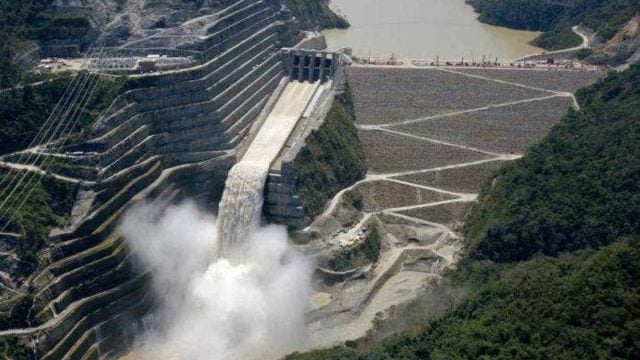More than 4,000 people had to leave their homes between July 21 and 27, in a new wave of forced displacement that occurred in the Ituango municipality, located in the department of Antioquia, in northwestern Colombia.
The cause of these new displacements —which also occurred in January and February of this year— was because of a warning that reached the communities about possible armed confrontations between the FARC dissidents and paramilitary groups of the Clan del Golfo; as well as the probable arrival of contingents from the Colombian Army and the National Police to confront them.
«The situation is even more critical with the confinement generated by the landslides (product of heavy downpours in the area), the instability of the roads and the inadequate interventions of the Hidroituango hydroelectric megaproject in the area», says the Ríos Vivos Movement according to review RT.
Hidroituango, to which Ríos Vivos refers, has become in recent years, in addition to the clashes between illegal armed groups and the security forces, one of the causes of the forced displacement of the inhabitants of Ituango and other municipalities of the region.
Population «revictimized» by Hidroituango
Hidroituango is a hydroelectric project that seeks to become the largest in Colombia and started to be ‘developed’ in the 1970s. However, its construction began in November 2010. The work includes a dam of 225 meters high and 20 million cubic meters volume, with which a 70-kilometer-long reservoir would be created and it is intended to have an installed capacity of 2,400 megawatts.
The dam, whose main shareholders are the Government of Antioquia and Empresas Públicas de Medellín (EPM) —which in turn is the executor—, is located on the Cauca river, the second most important in the country after the Magdalena, between the municipality of Ituango and the town of Puerto Valdivia, in Antioquia, but its area of influence covers 12 municipalities in total.
Since before its construction, this mega-project, which was intended to be ready in 2018, has generated ‘inconveniences’. «The Environmental Impact Study (EIA) of Hidroituango affirms that there are more negative impacts (24) than positive (3) EPM and the local and departmental administrations insist on pointing out the opposite, distorting the reality about the construction works and preventing that the environmental damage indicated by those affected is taken into account […] and the unforeseen impacts that are being caused”, denounces the Ríos Vivos Movement.
Among the negative impacts they mention are those related to air and water pollution, changes in the fluvial dynamics of the Cauca River and others in the environment; but, in addition, they include the «involuntary (forced) displacement of the population and the impact on their living conditions», as well as the «generation of conflicts motivated by the presence of the project».
One of the examples that Ríos Vivos highlights about the negative impacts of Hidroituango is that the construction of the dam implies the obstruction of the Cauca River, which «affects more than 26,000 hectares». In addition, this figure does not include «several populations traditionally settled downstream of the construction works that are already being impacted by the artificial management of the riverbed and the rupture or alteration of the biological chains in the basin».
With this, they mention that «about 60% of the population in this area is victim of the armed conflict and is being revictimized by Hidroituango».
Displaced in 2013
On March 20, 2013, a group of about 400 peasants from Briceño, San Andrés de Cuerquia, Toledo, Sabanalarga, Peque, Yarumal, Ituango and Liborina, affected by the megaproject, traveled on foot to Medellín, the capital of Antioquia, with the objective of holding a dialogue with those responsible for the work and the local and national authorities.
The march took place after being repressed by members of the Mobile Anti-riot Squad (Esmad) when they demonstrated against the hydroelectric plant in their territories. They then denounced damage to crops, houses and traditional roads due to the works of the dam, as well as stigmatization, threats and attacks on the part of the public forces.
«Our displacement to Medellín was not voluntary, we have arrived walking because of the harassment and threats we suffered from the National Police, the fear of being captured illegally and en masse, as happened to us on March 16, the fear of being prosecuted so as not to allow us to protest, nor exercise the right of assembly. Those events were the ones that pressured us to get to Medellín», said the Ríos Vivos Movement that year.
After this ‘exodus’, the claimants remained in the Coliseum of the University of Antioquia for seven months. On October 25 of that year they began to return to their homes.
Displaced in 2018
In April and May 2018 there were serious problems with the hydroelectric plant, due to planning errors, which had serious consequences for the population surrounding the mega-project, including Ituango.
To build the dam, the channel of the Cauca River was diverted and three diversion tunnels were created. Two of them were covered by the operators before filling the dam; but a landslide in the mountain covered the third, completely obstructing the flow of the river and the water began to be dammed, threatening to overflow.
«It happened when the necessary works for an operation of such magnitude had not yet been completed», says an article published this year by Isabel Cristina Zuleta, from the Rios Vivos Movement and resident of the Ituango municipality.
Downstream, an alert was generated, while upstream two towns were flooded: Ituango and Sabanalarga.
«The population downstream of the wall was evacuated and upstream rescued, but in both cases abandoned to their fate, with few interventions by the institutions», says Zuleta’s text.
Later, the tunnel that had collapsed was uncovered for a few minutes and produced an avalanche that destroyed homes and other infrastructure, such as bridges, hospitals, schools, churches and cemeteries, says Zuleta’s text.
Up to 113,000 people were evacuated – most of them returned little by little -, mainly from the towns of Puerto Valdivia and Puerto Antioquia, as well as from the municipalities of Cáceres and Tarazá, located on the banks of the Cauca, downstream from the hydroelectric plant.
«After these damages to the communities and the environment, no reparation was guaranteed for the people displaced by the project, who were already in a vulnerable situation», says the activist.
Activists murdered and displacements
Another thing that the Ríos Vivos Movement denounces is the increase in militarization in an area of high armed conflict.
“The project is building three military bases and plans to build more in the area, has multiple security agreements with the National Police and the Colombian National Army […] and has contracted two private security companies. The presence of these actors has resulted in attacks, stigmatization, persecution and threats to those affected and the opponents who express their complaints, nonconformity and rejection of the work», says the group.
Apart from all this, according to the human rights organization Front Line Defenders, in an article published in October last year, in 11 years of active resistance against Hidroituango, six members of the Ríos Vivos Movement and more than thirty other leaders and relatives have been murdered in the area affected by the work.
«These murders continue to go unpunished, and reflect the tragic trend in Colombia of an increase in violations against human rights defenders, particularly those who dare to defend the land and the environment in territories of acute violence», states the organization.
Last December – in addition – the Special Jurisdiction for Peace (JEP) reported that it was able to verify that 2,094 people were victims of forced disappearance in the area of influence of the Hidroituango hydroelectric plant.
«In this region, this very serious crime was massive, widespread and persistent, at the same time that, without a doubt, it greatly injured the communities», emphasizes the institution.











